| dc.contributor.author | Magnanelli, Elisa | |
| dc.contributor.author | Berglihn, Olaf Trygve | |
| dc.contributor.author | Kjelstrup, Signe | |
| dc.date.accessioned | 2019-02-22T13:27:05Z | |
| dc.date.available | 2019-02-22T13:27:05Z | |
| dc.date.created | 2018-11-14T11:23:14Z | |
| dc.date.issued | 2018 | |
| dc.identifier.citation | International Journal of Energy Research. 2018, 42 (13), 3989-4007. | nb_NO |
| dc.identifier.issn | 0363-907X | |
| dc.identifier.uri | http://hdl.handle.net/11250/2587067 | |
| dc.description.abstract | Key performance indicators (KPIs) are powerful tools that industries can use not only to monitor their activities but also to highlight their unexploited potential. Energy-based KPIs are nowadays mostly used to evaluate industrial process performances. However, these indicators might present some limitations and might give misleading results in some circumstances. An example is represented by industrial processes that make use of different energy forms (e.g. electricityandheat)andofdifferentmaterialinputs,andarethereforedifficulttocompareintermsofenergy. Afurther example can be found in the Carnot engine that, despite being ideal, can have quite low energy efficiency (e.g. the energy efficiency of a Carnot engine working between 700 K and 300 K is 57%), suggesting that its performance can be improved. The use of exergy-based KPIs allows us to overcome many of the limitations of energy-based indicators. The exergy efficiency of Carnot engines is 100%, clearly indicating that the system cannot be further improved. Moreover, the use of specific exergy consumption instead of specific energy consumption to monitor the performance of a process allows one to take into account possible differences in quality of material and energy streams. In thepresent work, exergy-basedKPIs for industrial use are reviewed. The paper outlines advantages andlimitations of the reviewed indicators, with the scope of promoting their use in industry. A systematic use of exergy-based KPIs not only gives a meaningful representation of process performances in terms of resource use, but it can also direct efforts to improve the processes. In order to better understand their meaning under different circumstances, the revised indicators are applied to three industrial processes. | nb_NO |
| dc.language.iso | eng | nb_NO |
| dc.publisher | Wiley | nb_NO |
| dc.title | Exergy-based performance indicators for industrial practice | nb_NO |
| dc.type | Journal article | nb_NO |
| dc.description.version | submittedVersion | nb_NO |
| dc.source.pagenumber | 3989-4007 | nb_NO |
| dc.source.volume | 42 | nb_NO |
| dc.source.journal | International Journal of Energy Research | nb_NO |
| dc.source.issue | 13 | nb_NO |
| dc.identifier.doi | 10.1002/er.4123 | |
| dc.identifier.cristin | 1630377 | |
| dc.description.localcode | This is the pre-peer reviewed version of an article, which has been published in final form at 10.1002/er.4123. This article may be used for non-commercial purposes in accordance with Wiley Terms and Conditions for Self-Archiving. | nb_NO |
| cristin.unitcode | 194,66,25,0 | |
| cristin.unitname | Institutt for kjemi | |
| cristin.ispublished | true | |
| cristin.fulltext | preprint | |
| cristin.qualitycode | 1 | |
